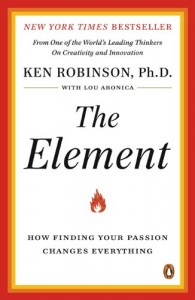Continuing to slowly make my way through Maria Popova‘s list of 7 Must-Read Books on Education, I recently picked up #2 on the list, The Element: How Finding Your Passion Changes Everything by Sir Ken Robinson. It only seemed fitting to read it this week, as I am going to see the man speak tonight at the Vancouver Playhouse Theatre.
Ken Robinson is perhaps best known for his TED talks (Do Schools Kill Creativity? and Bring on the Learning Revolution) and as the narrator of the brilliant RSA animate video, Changing Education Paradigms:
Celebrities and Creativity
In The Element, Â Robinson gives us countless examples of famous (and sometimes not so famous) people and the struggles they endured on the way to finding their passions. We learn that Paul McCartney hated music class as a teen, Aaron Sorkin wanted to be an actor, and that Meg Ryan wanted to be a writer. We’re treated to stories of people who defied the odds and pursued their passions, including Simpsons creator Matt Groening, Huffington Post founder Arianna Huffington, Nobel physicist Richard Feynman, and Fleetwood Mac founder Mick Fleetwood. At times I found myself getting a little bit tired of all the celebrity worship, although this format tapers off a bit towards the latter third of the book as Robinson begins to write at a more personal level. He provides some background about his own childhood and the hardships he faced in dealing with polio, realizing he would not be a professional soccer player, and then later excelling in school as a young teen, perhaps due to a fortunate change in policy in British education.
While the stories and interviews provide entertaining segues into the content of the book, the most enjoyable and rewarding passages come in spurts when Robinson goes into editorial mode, offering his views on particular topics. For instance, in comparing human beings to the rest of the species on Earth, Robinson notes that:
“Other species communicate, but they don’t have laptops. They sing, but they don’t produce musicals. They can be agile, but they didn’t come up with Cirque du Soleil. They can look worried, but they don’t publish theories on the meaning of life and spend their evenings drinking Jack Daniel’s and listening to Miles Davis. And they don’t meet at water holes, poring over images from the Hubble telescope and trying to figure out what those might mean for themselves and all other hyenas.”
For which he offers this explanation:
“What accounts for these yawning differences in how humans and other species on our small planet think and behave? My general answer is imagination. But this is really about the much more sophisticated evolution of the human brain and the highly dynamic ways in which it can work. The dynamics of human intelligence account for the phenomenal creativity of the human mind. And our capacity for creativity allows us to rethink our lives and our circumstances – and to find our way to the Element.â€
It’s a valid point, and if my memory serves me correctly, is similar to the message conveyed in the final chapters of Thomas L. Friedman‘s The World Is Flat. Imagination is what makes us human, and gives us the power and capacity to progress and evolve. Robinson goes on to define “creativity as applied imagination” which I think is a very insightful way to put it. We can imagine in our heads, but it takes creativity to turn our thoughts into meaningful products.
Transforming Education
I was first introduced to the notion that our educational institutions (and many other industries) were built on the infrastructure of the Industrial Revolution in Don Tapscott’s and Anthony D. Williams’ Macrowikinomics. After a year in the education program at UBC, I’ve seen and heard this idea countless times in articles, lectures, and hallway conversations. Ken Robinson offers similar suggestions, noting that:
“For more than three hundred years Western thought has been dominated by the images of industrialism and the scientific method. It’s time to change metaphors. We have to move beyond linear, mechanistic metaphors to more organic metaphors of human growth and development.â€
He goes on to offer a more organic metaphor relating to plants, farmers and gardeners: “The plant grows itself. Farmers and gardeners provide the conditions for growth.†The metaphor is quite similar to one offered by Douglas Thomas and John Seely Brown in A New Culture of Learning (#3 on the list), in which they suggest we should think of classroom culture as behaving more like a bacterial culture growing in a petri dish, cultivated by a teacher who acts as lab scientist, providing structure and conditions for growth.
Robinson believes that we face enormous challenges in the 21st century, and we are in need of a transformation:
“The fact is that given the challenges we face, education doesn’t need to be reformed – it needs to be transformed. The key to this transformation is not to standardize education but to personalize it, to build achievement on discovering the individual talents of each child, to put students in an environment where they want to learn and where they can naturally discover their true passions. The key is to embrace the core principles of the Element.”
I found this book to be enjoyable and inspiring, even if some parts of it were repeating points we’ve all seen in his TED talks. I’m looking forward to reading more from Ken Robinson, and even more so to seeing him speak tonight.